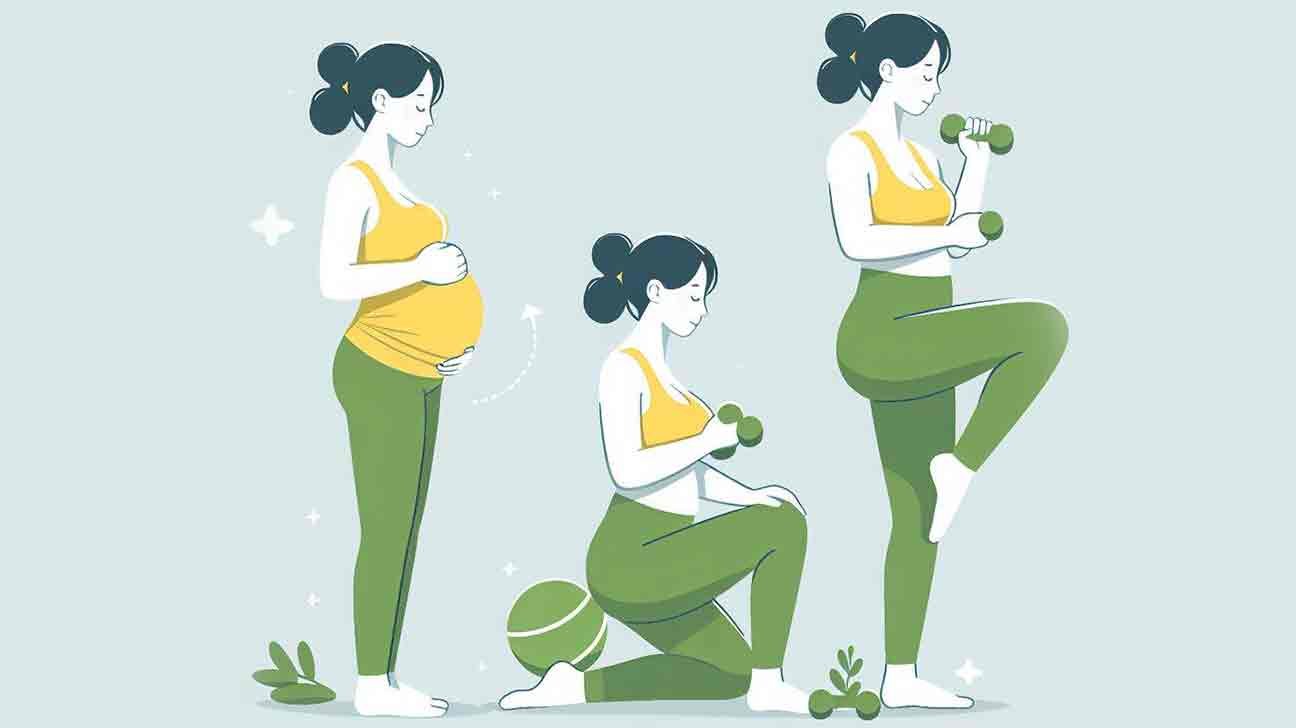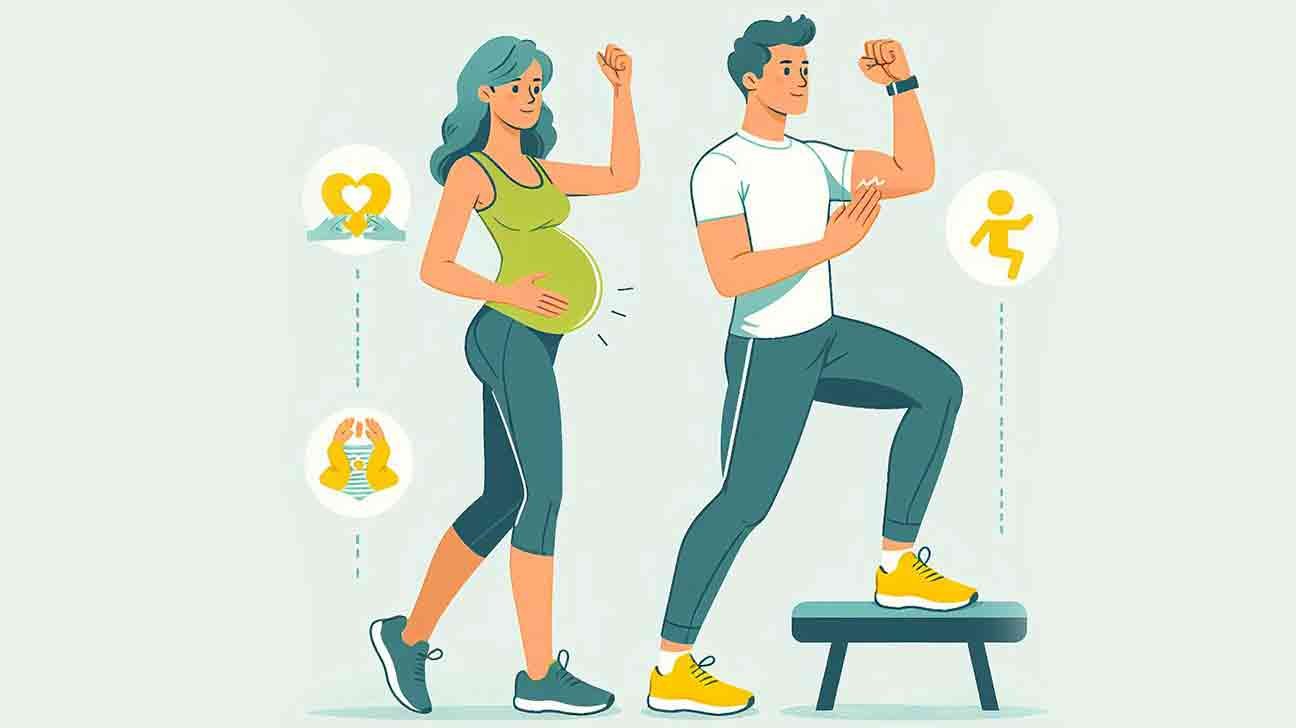After having a baby, it’s important to ease back into exercises gently, focusing on healing and rebuilding strength, particularly in the core, pelvic floor, and lower back. Here are some exercises that are generally safe to start with soon after delivery, but always consult your healthcare provider before beginning any postpartum exercise routine:
1. Pelvic Floor Exercises (Kegels)
- Why: Strengthens the pelvic floor muscles, which are often weakened during pregnancy and childbirth.
- How to Do: Contract the muscles you would use to stop the flow of urine, hold for a few seconds, and then release. Aim for several sets of 10-15 repetitions daily.
- Benefits: Helps prevent urinary incontinence and supports healing.
2. Diaphragmatic Breathing (Deep Belly Breathing)
- Why: Engages the core and helps reduce tension while aiding in post-pregnancy healing.
- How to Do: Lie on your back or sit up comfortably, place your hand on your abdomen, and take deep breaths, expanding your belly fully as you inhale. Exhale slowly, tightening your core muscles.
- Benefits: Helps re-engage core muscles and promote relaxation.
3. Pelvic Tilts
- Why: Strengthens abdominal muscles without straining the back.
- How to Do: Lie on your back with knees bent and feet flat on the floor. Tighten your stomach muscles and gently tilt your pelvis upward, flattening your back against the floor. Hold for a few seconds, then release.
- Benefits: Aids in improving core strength and posture.
4. Bridges
- Why: Strengthens glutes, hamstrings, and lower back muscles.
- How to Do: Lie on your back with knees bent and feet flat on the floor. Slowly lift your hips off the ground while keeping your shoulders on the floor, hold for a few seconds, and lower back down.
- Benefits: Builds strength in the lower body and supports postpartum pelvic stability.
5. Cat-Cow Stretches
- Why: Promotes spinal flexibility and gently stretches the core.
- How to Do: Start on all fours. Inhale and arch your back (cow pose), then exhale and round your spine upward (cat pose). Repeat this flow.
- Benefits: Helps relieve tension in the back and core while promoting mobility.
6. Walking
- Why: A low-impact, full-body workout that improves cardiovascular fitness and strengthens muscles.
- How to Do: Start with short, easy walks and gradually increase distance and pace.
- Benefits: Enhances circulation, boosts mood, and supports overall recovery.
7. Leg Slides
- Why: Strengthens abdominal muscles and engages core stabilization.
- How to Do: Lie on your back with knees bent, feet flat on the floor. Gently slide one leg out straight while keeping your back flat on the floor, then return to the starting position. Repeat on the other side.
- Benefits: Helps restore core strength without stressing the lower back.
Important Notes:
- Start Slowly: Allow your body to recover and only engage in exercises that feel comfortable.
- Listen to Your Body: If any exercise causes pain or discomfort, stop immediately.
- Post-Cesarean: Consult your healthcare provider for specific recommendations, as recovery timelines and allowed exercises may vary based on the type of delivery.
References:
- American College of Obstetricians and Gynecologists
- Mayo Clinic – Postpartum Exercise
- Healthline – Safe Postpartum Exercises

Postpartum exercises should be gentle and restorative, focusing on pelvic floor strength and deep breathing. Walking and stretching can also be beneficial activities for new mothers.
Regaining physical strength and well-being after childbirth is a journey that each new mother navigates differently. It’s essential to start with low-impact exercises that support the body’s natural recovery process. Gentle pelvic tilts and kegel exercises are excellent for strengthening the pelvic floor, which is crucial after delivering a baby.
Deep breathing techniques aid in relaxation and core engagement, which is vital for rebuilding abdominal strength. Light walking provides cardiovascular benefits without placing undue strain on the body. It’s important to listen to your body and consult with a healthcare professional before beginning any postpartum exercise regimen. This approach promotes healing, helps prevent injury, and supports a gradual return to a more active lifestyle.
Exercises You Can Do Right After Having A Baby
1. Considerations For Postpartum Exercise
Stepping into motherhood brings joy alongside physical challenges. After having a baby, your body needs time to recover. It’s tempting to jump back into your old workout routine. Yet, special considerations are key. Embracing light exercises can enhance recovery. It supports mental health. It also rebuilds core strength.
1.1. Importance Of Postpartum Exercise
Exercise after having a baby is not just about getting back in shape. It’s more nuanced than that. Exercise helps the body heal. It improves mood. It fights postpartum depression. With gentle movements, maternal bodies can regain flexibility. They can boost energy levels, too.
- Core strengthening: Reduces back pain, improves posture
- Mild aerobic activity: Uplifts mood, promotes better sleep
- Pelvic floor exercises: Enhances bladder control, reduces risk of prolapse
1.2. Consulting With Your Healthcare Provider
Before starting any exercise, a checkup is essential. Your doctor can give a green light. They might suggest waiting. Each body is different. Recovery times vary. Your healthcare provider can tailor advice. This ensures safety. It aligns with your specific needs.
- Discuss any concerns
- Review current health status
- Get personalized exercise recommendations
Remember, slow and steady wins the race. Rushing can do more harm than good. Take the steps discussed with your healthcare provider. Trust their guidance. Support your body through its healing journey.
2. Starting With Gentle Exercises
After giving birth, your body needs tender love and care. Begin your journey back to fitness with gentle exercises. These activities support recovery and help you reconnect with your body. Ready to ease into your postpartum exercise routine? Let’s explore some safe and effective moves!
2.1. Pelvic Floor Exercises
Strengthen your pelvic floor to regain control and reduce post-baby bladder leaks. Known as Kegels, these can be done anywhere, anytime. To perform Kegels:
- Sit or lie down comfortably.
- Squeeze the muscles you would use to stop urinating.
- Hold for three seconds, then relax for three seconds.
- Repeat ten times, three times a day.
2.2. Abdominal Breathing
Abdominal breathing supports core recovery and reduces stress. To practice:
- Lie flat with knees bent.
- Place hands on your belly.
- Breathe in deeply through your nose, expanding your stomach.
- Breathe out slowly through your mouth.
- Do this for five minutes daily.
2.3. Gentle Walking
Gentle walking improves circulation and boosts mood without straining your body. Start with short, slow walks. Gradually increase pace and distance as you feel more comfortable. Aim to walk for 15 to 30 minutes a day.
- Wear supportive shoes.
- Push your baby in a stroller for extra bonding.
- Drink plenty of water to stay hydrated.

3. Progressing To Strength Training
Gaining back strength postpartum is a journey. It’s vital to start slow and build gradually. Moving onto strength training can be a game-changer for new moms. It rebuilds muscle, boosts metabolism, and enhances energy levels. Let’s break down simple strength exercises that are safe and effective.
3.1. Bodyweight Exercises
Bodyweight exercises are an excellent starting point. They don’t require equipment and are gentle on your healing body. Here’s how you can incorporate them:
- Squats: Stand with feet hip-width apart, bend knees, and lower into a squat. Keep your back straight and chest lifted.
- Wall Push-ups: Start with hands on a wall at shoulder height. Bend elbows to bring your chest closer to the wall, then push back.
- Pelvic Tilts: Lie on your back with knees bent. Tighten your abs and tilt your hips upward. This helps tone your tummy.
3.2. Resistance Band Workouts
Resistance bands add light resistance to your training. They can help tone and strengthen muscles without strain. Try these safe workouts:
- Band Pull Aparts: Hold the band in front of you and pull it apart, squeezing shoulder blades together.
- Glute Bridges: Lie on your back, loop the band above your knees, and lift your hips. It works the backside.
- Seated Rows: Sit with legs out, wrap the band around your feet, and pull towards your waist, mimicking a rowing action.
3.3. Proper Form And Technique
Correct form is crucial to prevent injury and maximize the benefits of strength training. Here’s what to focus on:
- Breathe: Breathe out when you exert force, breathe in when you return to the starting position.
- Alignment: Align your body correctly. Shoulders stacked over hips, and hips over knees.
- Control: Move smoothly. Fast jerky movements can harm your body.
Remember, consulting with a healthcare provider before starting any new exercise regime is important.
4. Incorporating Cardio Exercises
Welcoming a new baby into the world is a beautiful experience that alters routines entirely. Post-pregnancy, your body needs gentle, effective ways to ease back into exercise. Cardio workouts play a vital role in improving stamina, aiding weight loss, and boosting mood. Let’s explore ideal post-partum cardio exercises.
4.1. Low-impact Cardio Options
After childbirth, your body needs workouts that are kind on the joints. Low-impact cardio is perfect for this phase. Try these options:
- Brisk Walking: A simple exercise to increase heart rate without strain.
- Swimming: Supports the body and eases joint stress.
- Cycling: Stationary bikes are great for rebuilding leg strength.
4.2. Interval Training
Interval training can kickstart metabolism and enhance energy levels. It involves short bursts of activity followed by rest. Here’s a simple post-partum interval routine:
- Walk fast for 1 minute.
- Slow down for 2 minutes.
- Repeat for 20–30 minutes.
4.3. Stroller Workouts
Stroller workouts are fabulous for new moms. They incorporate baby time with exercise, offering fresh air for both. Try these moves:
| Exercise | Description |
|---|---|
| Stroller Walk | Push the stroller in a brisk walk. |
| Stroller Squats | Squat while holding the stroller handle. |
| Stroller Lunges | Step forward into a lunge while pushing the stroller. |

5. Including Flexibility And Stretching Exercises
After childbirth, your body needs care and time to recover. Flexibility and stretching exercises are ideal. They’re gentle and help regain motion. Babies demand constant care. These exercises fit in your schedule. No need for heavy workouts. Let’s focus on flexibility and stretching for your postpartum journey.
5.1. Gentle Yoga
Gentle Yoga soothes and aligns your body. It involves slow movements. This is perfect for new moms. It improves posture, reduces stress, and increases flexibility. Try poses like Cat-Cow, Child’s Pose, and Legs-Up-The-Wall. They help tight areas. Always listen to your body. Stop if it hurts. Aim for 10-15 minutes each day. Start slow and build up.
5.2. Stretching For Muscle Recovery
Stretching for muscle recovery is key post-baby. It helps sore and tight muscles. Aim to stretch daily. Focus on neck, shoulders, back, and hips. These areas get tight from nursing and holding your baby. Use a comfortable mat. Hold each stretch for 15-30 seconds. Don’t rush. Breathe deeply. This relaxes your muscles more. It feels good and helps with recovery.
6. Joining Postpartum Exercise Classes
Embracing motherhood doesn’t mean you have to put your fitness on hold! Postpartum exercise classes are a fantastic way to step back into a fitness routine. Tailored for new moms, these sessions understand your unique needs. Let’s explore the benefits and how to find the perfect class for you.
6.1. Benefits Of Postpartum Exercise Classes
- Meet other new moms and build a support network.
- Regain strength in a safe, structured environment.
- Focus on specific postpartum needs, like pelvic floor recovery.
- Reduce stress and combat postnatal depression symptoms.
- Get professional guidance to exercise safely.
6.2. Finding A Suitable Class
Ready to join a postpartum exercise class? Start by asking your healthcare provider for recommendations. They understand your specific situation best. Next, check your local gym or community center for classes.
Don’t forget to consider online options, which can be more flexible. Look for sessions that match your current fitness level and postpartum stage. Read reviews and possibly try a free session to ensure it feels right for you.
7. Tips For Exercising Safely
Embarking on your postnatal fitness journey requires caution and care. Here are essential tips to ensure your exercise routine post-baby is both effective and safe.
7.1. Listening To Your Body
Your body knows best. Start with light activities and watch for any discomfort.
- Signs to stop: Pain, exhaustion, or any unusual symptoms.
- Rest is key: Allow adequate recovery between sessions.
7.2. Gradual Progression
Rome wasn’t built in a day. Increase intensity at a rate your body can manage.
- Start with short sessions, perhaps 10-15 minutes.
- Slowly add more time or reps each week.
7.3. Proper Nutrition And Hydration
Pairing exercise with healthy eating and drinking speeds up recovery.
| Aspect | Tip |
|---|---|
| Nutrition | Focus on a balanced diet with proteins, fibers, and vitamins. |
| Hydration | Drink water before, during, and after your workout. |

8. Getting Support And Accountability
Starting exercise after having a baby feels overwhelming. It’s a journey you need not walk alone. Support networks play a critical role in your fitness comeback. Lean on friends, online communities, or professionals. They keep you motivated and on track. Let’s explore impactful support options.
8.1. Partner Or Friend
Working out with someone close to you brings numerous benefits. They understand your needs and provide emotional support. Schedule regular walks or workout sessions together. This creates a fun and encouraging exercise routine.
8.2. Online Support Groups
The internet is home to countless online support groups. These communities connect moms worldwide. Share stories, tips, and goals with women on the same journey. Receiving virtual cheers pushes you forward.
8.3. Hiring A Postpartum Fitness Coach
A postpartum fitness coach specializes in post-birth workouts. They guide you through safe and effective exercises. Their expert knowledge assures your path to fitness aligns with your health. Invest in a coach for personalized support.
Frequently Asked Questions For The Exercises You Can Do Right After Having A Baby No Its Not What You Think
What Are Safe Postpartum Exercises?
Gentle walking is safe soon after delivery, aiding in recovery and circulation. Pelvic floor exercises are also recommended, helping to strengthen key muscles affected by childbirth.
Can I Do Pelvic Tilts Post-baby?
Yes, pelvic tilts are beneficial for postpartum core strengthening. Begin with gentle tilts, lying on your back with knees bent, to engage and strengthen abdominal muscles.
When Can I Start Postnatal Yoga?
Typically, postnatal yoga is safe 6-8 weeks post-birth, but always consult with a healthcare provider first. It helps in regaining flexibility and reducing stress.
How Does Exercise Benefit After Childbirth?
Exercise post-birth enhances physical and mental health. It aids in weight management, improves mood, and restores muscle strength, contributing to overall well-being.
Conclusion
Embarking on postpartum exercises can be transformative for new moms. Gentle moves not only boost recovery, but also enhance well-being. So, start slow, prioritize safety, and embrace your journey back to fitness. Remember, consulting a healthcare provider is key. Here’s to embracing motherhood with strength and vitality!



